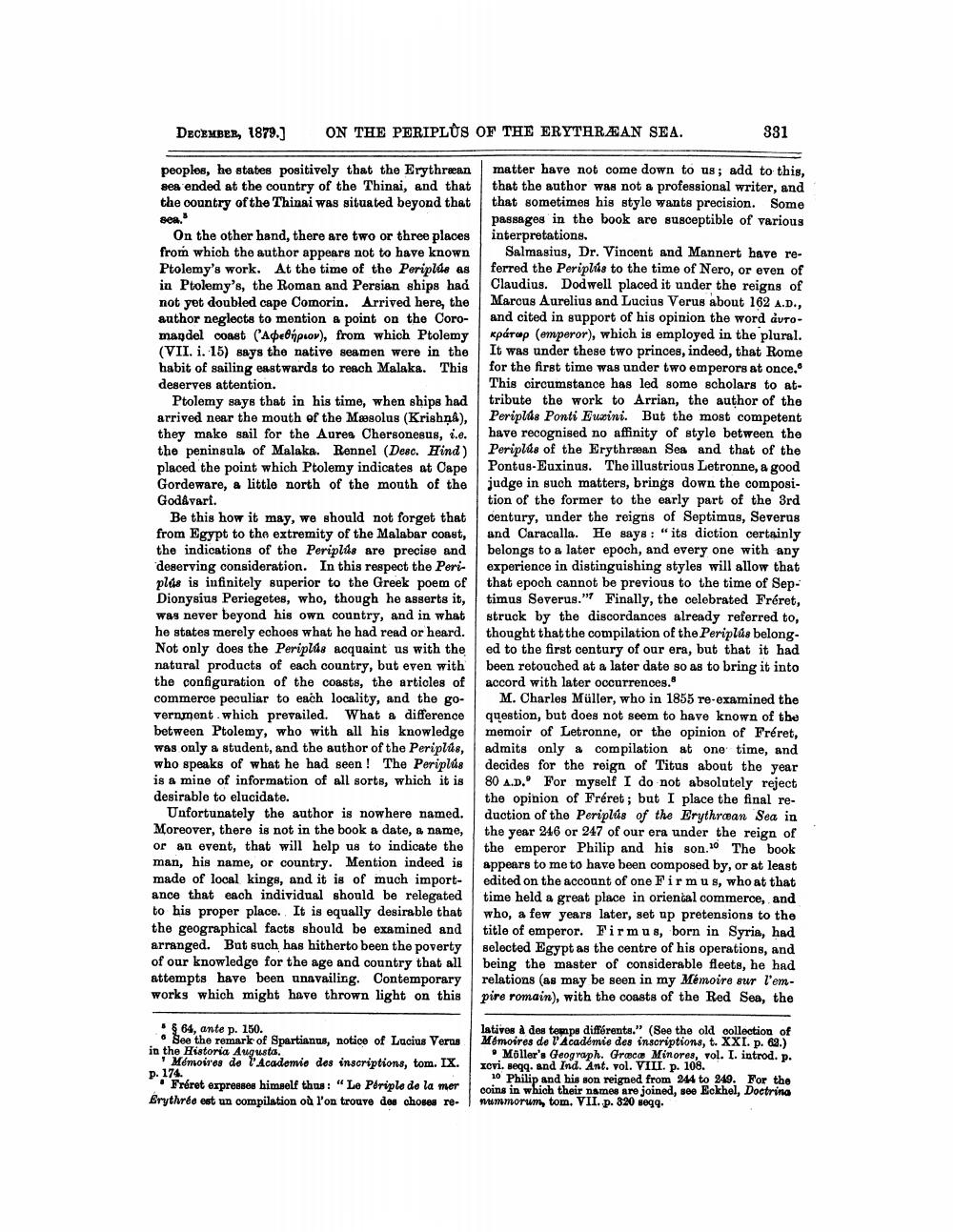________________
DECEMBER, 1879.)
ON THE PERIPLUS OF THE ERYTHRÆAN SEA.
331
peoples, he states positively that the Erythræan sea ended at the country of the Thinai, and that the country of the Thinai was situated beyond that
sea.
On the other hand, there are two or three places from which the author appears not to have known Ptolemy's work. At the time of the Periplús as in Ptolemy's, the Roman and Persian ships had not yet doubled cape Comorin. Arrived here, the author neglects to mention a point on the Coromandel coast (Acehprov), from which Ptolemy (VII. i. 15) says the native seamen were in the habit of sailing eastwards to reach Malaka. This deserves attention.
Ptolemy says that in his time, when ships had arrived near the mouth of the Mesolus (Krishna), they make sail for the Aurea Chersonesus, i.e. the peninsula of Malaka. Rennel (Desc. Hind) placed the point which Ptolemy indicates at Cape Gordeware, a little north of the mouth of the Godavari.
Be this how it may, we should not forget that from Egypt to the extremity of the Malabar coast, the indications of the Periplus are precise and deserving consideration. In this respect the Periplús is infinitely superior to the Greek poem of Dionysius Periegetes, who, though he asserts it, was never beyond his own country, and in what he states merely echoes what he had read or heard Not only does the Periplas acquaint us with the natural products of each country, but even with the configuration of the coasts, the articles of commerce peculiar to each locality, and the government which prevailed. What a difference between Ptolemy, who with all his knowledge was only a student, and the author of the Periplus, who speaks of what he had seen! The Periplus is a mine of information of all sorts, which it is desirable to elucidate.
Unfortunately the author is nowhere named. Moreover, there is not in the book a date, a name, or an event, that will help us to indicate the man, his name, or country. Mention indeed is made of local kings, and it is of much importance that each individual should be relegated to his proper place. It is equally desirable that the geographical facts should be examined and arranged. But such has hitherto been the poverty of our knowledge for the age and country that all attempts have been unavailing. Contemporary works which might have thrown light on this
matter have not come down to us; add to this, that the author was not a professional writer, and that sometimes his style wants precision. Some passages in the book are susceptible of various interpretations.
Salmasius, Dr. Vincent and Mannert have referred the Periplús to the time of Nero, or even of Claudius. Dodwell placed it under the reigns of Marcus Aurelius and Lucius Verus about 162 A.D., and cited in support of his opinion the word autokpárop (emperor), which is employed in the plural. It was under these two princes, indeed, that Rome for the first time was under two emperors at once. This circumstance has led some scholars to attribute the work to Arrian, the author of the Periplus Ponti Euxini. But the most competent have recognised no affinity of style between the Periplus of the Erythræan Sea and that of the Pontus-Euxinus. The illustrious Letronne, a good judge in such matters, brings down the composition of the former to the early part of the 3rd century, under the reigns of Septimus, Severus and Caracalla. He says: "its diction certainly belongs to a later epoch, and every one with any experience in distinguishing styles will allow that that epoch cannot be previous to the time of Septimus Severus." Finally, the celebrated Fréret, struck by the discordances already referred to, thought that the compilation of the Periplus belonged to the first century of our era, but that it had been retouched at a later date so as to bring it into accord with later occurrences.
M. Charles Müller, who in 1855 re-examined the question, but does not seem to have known of the memoir of Letronne, or the opinion of Fréret, admits only a compilation at one time, and decides for the reign of Titus about the year 80 A.D. For myself I do not absolutely reject the opinion of Fréret; but I place the final reduction of the Periplús of the Erythroan Sea in the year 246 or 247 of our era under the reign of the emperor Philip and his son. The book appears to me to have been composed by, or at least edited on the account of one Firmus, who at that time held a great place in oriental commerce, and who, a few years later, set up pretensions to the title of emperor. Firmus, born in Syria, had selected Egypt as the centre of his operations, and being the master of considerable fleets, he had relations (as may be seen in my Mémoire sur l'empire romain), with the coasts of the Red Sea, the
964, ante p. 150. • See the remark of Spartianus, notice of Lucius Verus in the Historia Augusta.
Mémoires de l'Academie des inscriptions, tom. IX. p. 174.
Fréret expresses himself thus : "Le Périple de la mer Erythrée est un compilation où l'on trouve des choses re
latives à des temps différents." (See the old collection of Mémoires de l'Académie des inscriptions, t. XXI. p. 62.)
• Möller's Geograph. Graco Minores, vol. I. introd. p. xcvi. seqq. and Ind. Ant. vol. VIII. p. 108.
10 Philip and his son reigned from 244 to 249. For the coins in which their names are joined, see Eckhel, Doctrina mammorum, tom. VII. p. 320 segg.




